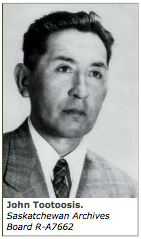
Tootoosis, John Baptiste (1899– 1989). A central figure in the development of modern Indian political organizations, Tootoosis was a tireless promoter and defender of treaty rights, and deserves some of the credit for the entrenchment of Aboriginal rights in the 1982 Constitution Act. Tootoosis was born on Poundmaker Reserve on July 18, 1899, of Cree, Assiniboine and Métis ancestry. His grandfather was Yellow Mud Blanket, brother of the legendary Cree Chief Poundmaker. He enjoyed a sheltered childhood in a close-knit family until the age of 13, when his father sent him to Delmas Residential School to receive a Euro-Canadian education. It was an extremely traumatic experience, which resulted in his lifelong criticism of the residential school system and of the control the Roman Catholic Church exercised over Indigenous people. Tootoosis returned to the reserve when he was 17, and his father gradually introduced him to the community’s political system, where he developed a solid grasp of his people’s history and treaty rights. When the Poundmaker band council decided to select a new chief in 1920, the young Tootoosis was their first choice; however, the Indian Act’s regulations stipulated that chiefs had to be at least 25 years old, and Tootoosis was replaced with another candidate. He began to assert a leadership role in the community anyway, resisting the efforts of government officials to alienate part of the Poundmaker Reserve land base. His entry into the political arena coincided with the appearance of a new assertiveness among Indigenous peoples across Canada following World War I. When Tootoosis’ father passed away in 1932, he was chosen to represent the Battleford bands in the League of Indians of Western Canada. Throughout the 1930s and 1940s he travelled across Canada, receiving no salary and relying on small donations from individuals. His efforts finally bore fruit in the years after World War II. In 1946, Tootoosis was instrumental in the amalgamation of the various Indigenous organizations in Saskatchewan into the Union of Saskatchewan Indians. In 1959, the original Union was transformed into the Federation of Saskatchewan Indians, and Tootoosis was elected its first president. He made the promotion and defense of treaty rights his main priority.
In 1970 Tootoosis was appointed to the Senate of the Federation of Saskatchewan Indians, and served as an active elder statesman for the remainder of his life; he also served as Ambassador to the World Council of Indigenous People conferences held in Canada, the USA, South America, Australia and Sweden, and was appointed a member of the Order of Canada in 1986. Tootoosis was married in 1929 to Louisa Angus from Thunderchild Reserve and together they had thirteen children; their children and grandchildren continue his example of service to First Nations peoples. He died on February 2, 1989
Michael Cottrell

